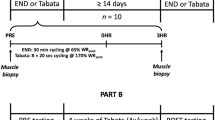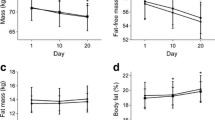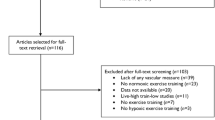Abstract
We previously reported that high load resistance exercise with superimposed whole-body vibration and sustained vascular occlusion (vibroX) markedly improves cycling endurance capacity, increases capillary-to-fibre ratio and skeletal muscle oxidative enzyme activity in untrained young women. These findings are intriguing, since increases in oxidative muscle phenotype and endurance capacity are typically induced by endurance but not heavy resistance exercise. Here, we tested the hypothesis that vibroX activates genes associated with mitochondrial biogenesis and angiogenesis. Eight healthy, recreationally resistance-trained young men performed either vibroX or resistance exercise (RES) in a randomised, cross-over design. Needle biopsies (M. vastus lateralis) were obtained at rest and 3 h post-exercise. Changes in relative gene expression levels were assessed by real-time quantitative PCR. After vibroX, vascular endothelial growth factor and peroxisome proliferator-activated receptor-γ coactivator 1α mRNA abundances increased to 2- and 4.4-fold, respectively, but did not significantly change above resting values after RES. Other genes involved in mitochondrial biogenesis were not affected by either exercise modality. While vibroX increased the expression of hexokinase II, xanthine dehydrogenase, and manganese superoxide dismutase mRNA, there were no changes in these transcripts after RES. This study demonstrates that high load resistance exercise with superimposed whole-body vibration and sustained vascular occlusion activates metabolic and angiogenic gene programs, which are usually activated after endurance but not resistance exercise. Thus, targeted modification of high load resistance exercise by vibration and vascular occlusion might represent a novel strategy to induce endurance-type muscle adaptations.





Similar content being viewed by others
References
Ameln H, Gustafsson T, Sundberg CJ, Okamoto K, Jansson E, Poellinger L, Makino Y (2005) Physiological activation of hypoxia inducible factor-1 in human skeletal muscle. FASEB J 19:1009–1011
American college of sports medicine position stand (2009) Progression models in resistance training for healthy adults. Med Sci Sports Exerc 41:687–708
Arany Z, Foo SY, Ma Y, Ruas JL, Bommi-Reddy A, Gimun G, Cooper M, Laznik D, Chinsomboon J, Rangwala SM, Baek KH, Rosenzweig A, Spiegelman BM (2008) HIF-independent regulation of VEGF and angiogenesis by the transcriptional coactivator PGC-1 alpha. Nature 451:1008–1012
Chinsomboon J, Ruas J, Gupta RK, Thom R, Shoag J, Rowe GC, Sawada N, Raghuram S, Arany Z (2009) The transcriptional coactivator PGC-1 alpha mediates exercise-induced angiogenesis in skeletal muscle. Proc Natl Acad Sci USA 106:21401–21406
Coffey VG, Hawley JA (2007) The molecular bases of training adaptation. Sports Med 37:737–763
Cohen J (1988) Statistical power analysis for the behavioral sciences. Lawrence Erlbaum, 2nd edn. Hillsdale, New Jersey
De Luca CJ, Foley PJ, Erim Z (1996) Motor unit control properties in constant-force isometric contractions. J Neurophysiol 76:1503–1516
Egan B, Carson BP, Garcia-Roves PM, Chibalin AV, Sarsfield FM, Barron N, McCaffrey N, Moyna NM, Zierath JR, O’Gorman DJ (2010) Exercise intensity-dependent regulation of peroxisome proliferator-activated receptor coactivator-1 mRNA abundance is associated with differential activation of upstream signalling kinases in human skeletal muscle. J Physiol 588:1779–1790
Forsythe JA, Jiang BH, Iyer NV, Agani F, Leung SW, Koos RD, Semenza GL (1996) Activation of vascular endothelial growth factor gene transcription by hypoxia-inducible factor 1. Mol Cell Biol 16:4604–4613
Geng T, Li P, Okutsu M, Yin X, Kwek J, Zhang M, Yan Z (2010) PGC-1 alpha plays a functional role in exercise-induced mitochondrial biogenesis and angiogenesis but not type–type transformation in mouse skeletal muscle. Am J Physiol Cell Physiol 298:C572–C579
Godin R, Ascah A, Daussin FN (2010) Intensity-dependent activation of intracellular signalling pathways in skeletal muscle: role of fibre type recruitment during exercise. J Physiol 588:4073–4074
Gustafsson T, Puntschart A, Kaijser L, Jansson E, Sundberg CJ (1999) Exercise induced expression of angiogenesis-related transcription and growth factors in human skeletal muscle. Am J Physiol 276:H679–H685
Gustafsson T, Knutsson A, Puntschart A, Kaijser L, Nordqvist AC, Sundberg CJ, Jansson E (2002) Increased expression of vascular endothelial growth factor in human skeletal muscle in response to short-term one-legged exercise training. Pflugers Arch 444:752–759
Hellsten-Westing Y (1993) Immunohistochemical localisation of xanthine oxidase in human cardiac and skeletal muscle. Histochemistry 100:215–222
Holloszy JO, Coyle EF (1984) Adaptations of skeletal muscle to endurance exercise and their metabolic consequences. J Appl Physiol 56:831–838
Item F, Denkinger J, Fontana P, Weber M, Boutellier U, Toigo M (2011) Combined effects of whole-body vibration, resistance exercise, and vascular occlusion on skeletal muscle and performance. Int J Sports Med 32:781–787
Kang C, O’Moore KM, Dickman JR, Ji LL (2009) Exercise activation of muscle peroxisome proliferator-activated receptor-gamma coactivator-1 alpha signalling is redox sensitive. Free Radic Biol Med 47:1394–1400
Nordsborg NB, Lundby C, Leick L, Pilegaard H (2010) Relative workload determines exercise-induced increases in PGC-1 alpha mRNA. Med Sci Sports Exerc 42:1477–1484
Norrbom J, Sundberg CJ, Ameln H, Kraus WE, Jansson E, Gustafsson T (2004) PGC-1 alpha mRNA expression is influenced by metabolic perturbation in exercising human skeletal muscle. J Appl Physiol 96:189–194
Olfert IM, Howlett RA, Wagner PD, Breen EC (2010) Myocyte vascular endothelial growth factor is required for exercise-induced skeletal muscle angiogenesis. Am J Physiol Regul Integr Comp Physiol 299:R1059–R1067
Pilegaard H, Saltin B, Neufer PD (2003) Exercise induces transient transcriptional activation of the PGC-1 alpha gene in human skeletal muscle. J Physiol 546:851–858
Prior BM, Yang HT, Terjung RL (2004) What makes vessels grow with exercise training? J Appl Physiol 97:1119–1128
Puigserver P, Spiegelman BM (2003) Peroxisome proliferator-activated receptor- gamma coactivator 1 alpha (PGC-1 alpha): transcriptional coactivator and metabolic regulator. Endocr Rev 24:78–90
Richardson RS, Wagner H, Mudaliar SR, Henry R, Noyszewski EA, Wagner PD (1999) Human VEGF gene expression in skeletal muscle: effect of acute normoxic and hypoxic exercise. Am J Physiol 277:H2247–H2252
Rittweger J, Schiessl H, Felsenberg D (2001) Oxygen-uptake during whole body vibration exercise: comparison with squatting as a slow voluntary movement. Eur J Appl Physiol 86:169–173
Rittweger J, Ehrig J, Just K, Mutschelknauss M, Kirsch KA, Felsenberg D (2002) Oxygen uptake in whole-body vibration exercise: influence of vibration frequency, amplitude, and external load. Int J Sports Med 23:428–432
Rosnow RL, Rosenthal R, Rubin DB (2000) Contrasts and correlations in effect-size estimation. Psychol Sci 11:446–453
Scarpulla RC (2002) Nuclear activators and coactivators in mammalian mitochondrial biogenesis. Biochim Biophys Acta 1576:1–14
St-Pierre J, Lin J, Krauss S, Tarr PT, Yang R, Newgard CB, Spiegelman BM (2003) Bioenergetic analysis of peroxisome proliferator-activated receptor gamma coactivators 1 alpha and 1 beta (PGC-1 alpha and PGC-1 beta) in muscle cells. J Biol Chem 278:26597–26603
St-Pierre J, Drori S, Uldry M, Silvaggi JM, Rhee J, Jaeger S, Handschin C, Zheng K, Lin J, Yang W, Simon DK, Bachoo R, Spiegelman BM (2006) Suppression of reactive oxygen species and neurodegeneration by the PGC-1 transcriptional coactivators. Cell 127:397–408
Suga T, Okita K, Morita N, Yokota T, Hirabayashi K, Horiuchi M, Takada S, Omokawa M, Kinugawa S, Tsutsui H (2010) Dose effect on intramuscular metabolic stress during low-intensity resistance exercise with blood flow restriction. J Appl Physiol 108:1563–1567
Suhr F, Brixius K, de Marees M, Boelck B, Kleinoeder H, Achtzehn S, Bloch W, Mester J (2007) Effects of short-term vibration and hypoxia during high-intensity cycling exercise on circulating levels of angiogenic regulators in humans. J Appl Physiol 103:474–483
Sundberg CJ (1994) Exercise and training during graded leg ischaemia in healthy man with special reference to effects on skeletal muscle. Acta Physiol Scand 615:1–50
Tang JE, Hartman JW, Phillips SM (2006) Increased muscle oxidative potential following resistance training induced fibre hypertrophy in young men. Appl Physiol Nutr Metab 31:495–501
Tesch PA (1988) Skeletal muscle adaptations consequent to long-term heavy resistance exercise. Med Sci Sports Exerc 20:S132–S134
Toigo M, Boutellier U (2006) New fundamental resistance exercise determinants of molecular and cellular muscle adaptations. Eur J Appl Physiol 97:643–663
Vina J, Gimeno A, Sastre J, Desco C, Asensi M, Pallardo FV, Cuesta A, Ferrero JA, Terada LS, Repine JE (2000) Mechanism of free radical production in exhaustive exercise in humans and rats; role of xanthine oxidase and protection by allopurinol. IUBMB Life 49:539–544
Wang Y, Kerrick WG (2002) The off rate of Ca2+ from troponin C is regulated by force-generating cross bridges in skeletal muscle. J Appl Physiol 92:2409–2418
Wenger RH (2002) Cellular adaptation to hypoxia: O2-sensing protein hydroxylases, hypoxia-inducible transcription factors, and O2-regulated gene expression. FASEB J 16:1151–1162
Wilkinson SB, Phillips SM, Atherton PJ, Patel R, Yarasheski KE, Tarnopolsky MA, Rennie MJ (2008) Differential effects of resistance and endurance exercise in the fed state on signalling molecule phosphorylation and protein synthesis in human muscle. J Physiol 586:3701–3717
Wu Z, Puigserver P, Andersson U, Zhang C, Adelmant G, Mootha V, Troy A, Cinti S, Lowell B, Scarpulla RC, Spiegelman BM (1999) Mechanisms controlling mitochondrial biogenesis and respiration through the thermogenic coactivator PGC-1. Cell 98:115–124
Acknowledgments
We thank the participants for their effort and time commitment. This work was supported by the University of Zurich research priority program “Integrative Human Physiology” and the Zürcher Kantonalbank (ZKB). The Galileo® vibration plate was kindly provided by Novotec, Pforzheim, Germany.
Conflict of interest
The authors declare no conflict of interests.
Ethical standard
The experimental protocol was approved by the ethics committee of the canton of Zurich, and the study was performed in accordance with the ethical standards laid down in the Declaration of Helsinki for human experimentation.
Author information
Authors and Affiliations
Corresponding author
Additional information
Communicated by Martin Flueck.
Rights and permissions
About this article
Cite this article
Item, F., Nocito, A., Thöny, S. et al. Combined whole-body vibration, resistance exercise, and sustained vascular occlusion increases PGC-1α and VEGF mRNA abundances. Eur J Appl Physiol 113, 1081–1090 (2013). https://doi.org/10.1007/s00421-012-2524-4
Received:
Accepted:
Published:
Issue Date:
DOI: https://doi.org/10.1007/s00421-012-2524-4




